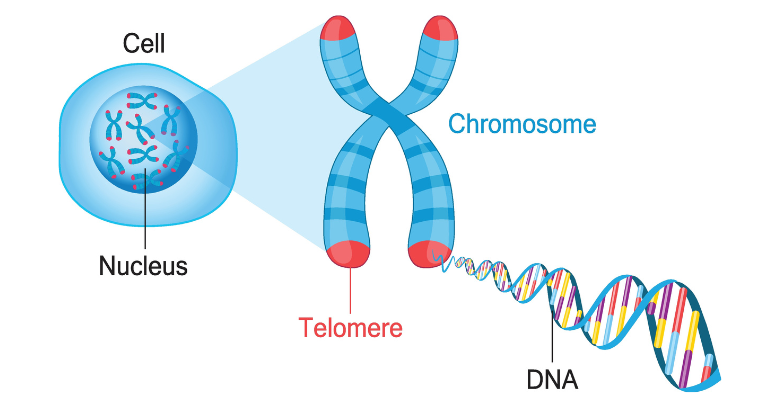Are Your Telomeres Short? Risks And Solutions
We all want to stay young, live longer, and remain active and sharp as we journey through life. While there may not be one single pill or magic formula for anti-aging, we’ve found many lifestyle tools that help to preserve or reverse biological age.
Biological age is different from chronological age, how old we are in years, but is a fast-growing area of medicine.
One of the first tools that we’ve had to measure biological age is telomere length.
Long telomeres reflect youth and health, while shorter telomeres predict aging and disease.
If you’re curious about your telomeres and what you can do to prevent them from shortening, keep reading.
This article will discuss:
- The science of telomeres
- What causes telomeres to shorten
- What health problems are associated with short telomeres
- What we know about the connection between telomeres and Covid
- How to promote healthy telomeres to prevent disease and promote longevity
What Are Telomeres?
Telomeres are the protective caps on the end of every chromosome. Think about them like the plastic cap on the end of a shoelace.
The job of telomeres is to protect DNA against damage and instability. Telomerase is the enzyme responsible for making telomeres. The body dedicates resources to maintaining telomeres and as they break down, there is some capacity to regenerate.
Telomeres are long when we are born and play an important role in DNA replication that allows us to grow and develop. Telomeres get shorter with each DNA replication and, therefore, shorter as we age.
The length of telomeres is a measurement of biological age. Another measurement of biological age is the epigenetic clock which looks at DNA methylation. Although they measure different aspects of aging, they correlate.
Telomere length passes through generations, likely because of epigenetics as well as the influence of the shared environment within families.
What Shortens Telomeres?
All of us will experience some shortening of our telomeres as we get older; however, some people’s telomeres shorten much more quickly.
Here are some of the factors that contribute to short telomeres:
- Poor diet and nutrient deficiencies
- Smoking
- Sedentary lifestyle
- Excess body fat
- Oxidative stress
- Inflammation
- Mitochondrial dysfunction
- BPA exposure
- Chronic stress
- Early puberty
Let’s take a closer look at a couple of these factors. One study showed that women with the highest levels of perceived stress, when compared to women with low stress, had significantly shorter telomeres. The difference was equivalent to being a decade older!
Other research correlates early puberty with shorter telomere length. Generational research suggests that mothers with earlier onset of their menstrual cycles had babies with shorter telomere lengths.
This correlation is significant given that telomeres should be their longest at birth and are a predictor of lifespan and health outcomes.
Risks of Short Telomeres and Link To Covid
Just as long telomeres are associated with longevity and health, short telomeres are associated with aging and disease.
When telomeres shorten, and the body doesn’t have the resources to protect and maintain them, they become dysfunctional and can’t protect DNA.
Short telomere length is associated with:
- Cancer
- Type 2 diabetes
- Hypertension
- Chronic kidney disease
- Pulmonary disease
- Heart disease
- Bone marrow disease
- Leukemia
- Osteoarthritis
- Mood disorders
- Higher risk of infection
Interestingly, there is overlap between epidemiological evidence and short telomeres and Covid-19 infection severity. Observational research during the first wave of the Covid pandemic in 2020 looked at telomere length via blood samples in those hospitalized with Covid.
Results suggested that shorter telomere length was associated with dying from Covid, while longer telomeres correlated with a reduced risk of death. The connection was robust in women compared to men, possibly because of lifestyle factors or comorbidities.
For women, the risk of dying from Covid 30 days after leaving the hospital was 70% lower in women with longer telomeres. This was even true of women over 65 who have a higher risk of Covid death simply because of age, but in this case, longer telomeres appeared to be protective.
How To Improve Telomere Length
The more we learn about telomeres, the more critical it becomes to keep them long and protected so that they can protect our DNA and slow the development of diseases associated with aging.
We can do many things in our daily lives that naturally lengthen telomeres, improve biological age, and prevent disease.
You’ve likely heard of many of these interventions before regarding longevity and disease prevention; telomeres might be one explanation as to why these lifestyle pieces have so many benefits.
Here are some natural ways to improve the length of telomeres:
1. Exercise. Exercise and particularly endurance training and high-intensity intervals improve telomerase activity, telomere length, and healthy aging, compared to resistance training which has other benefits for aging, including maintaining muscle mass.
2. Eat a nutrient-dense diet. Real food, like our ancestors ate, is the best protection against aging. It contains more vitamins, minerals, phytonutrients, and other nutrition components essential for healthy telomeres. Lower intake of folate, vitamin B12, antioxidants, and omega 3’s are associated with shorter telomeres. Eating more foods rich in these nutrients provides the resources the body needs to build and protect telomeres.
Get started with anti-aging and telomere-lengthening recipes here. Be sure to include dark leafy green vegetables daily or multiple times per day for adequate folate. Taking a multivitamin and greens power are good insurance policies to add to your routine.
3. Don’t smoke or vape. Cigarette smoke is a toxin and carcinogen that shortens telomeres and increases oxidative stress and inflammation in the body. Be careful of secondhand smoke and thirdhand smoke as well.
4. Avoid BPA and other toxins. Bisphenol A is found in plastics, canned foods, and receipts, but it isn’t the only toxin that increases oxidative stress and damages telomeres. We must be vigilant about the products we allow into our homes, the quality of food we put into our bodies, and work to reduce and prohibit more toxins from entering our air and water.
5. Sleep more. Sleep is critical for detoxification, repair, and regeneration. Yes, even for telomeres! One study in postmenopausal women correlates longer sleep duration with longer telomere length. Learn more and improve your sleep with these sleep tips.
6. Reduce stress. Stress is an underlying factor in all chronic disease and while we certainly can’t eliminate all stress, we can work to improve our relationship with it by practicing self-care, self-compassion, and finding more pleasure and joy in our lives. Remember that high stress was associated with telomeres that reflect aging by as much as 10 years!
7. Meditate regularly. Meditation, yoga, and breathwork help with stress reduction and management, and are also important tools for protecting our DNA and maintaining telomeres.
If you are new to meditation, you may want to start with an app that offers guided meditations. Or, you may want to invest in a feedback device such as HeartMath or Muse to get real-time information about how your nervous system responds to meditation and breathwork.
What came first, the short telomeres or the disease? They seem to go together. It makes sense that the same diet and lifestyle strategies that prevent disease and improve longevity and health span also help preserve telomere length and function.
The good news is that it may only take the simplest of lifestyle habits – eating real food, moving your body, getting good sleep, and managing stress.
These habits are foundational for health and reflected in many things that science now allows us to measure, including telomeres.
Read more about how you can help preserve and lengthen telomeres with Diet and Exercise, click here.
References
- https://www.ncbi.nlm.nih.gov/pmc/articles/PMC4051234/
- https://pubmed.ncbi.nlm.nih.gov/30137208/
- https://www.ncbi.nlm.nih.gov/pmc/articles/PMC7199797/
- https://pubmed.ncbi.nlm.nih.gov/29643374/
- https://www.ncbi.nlm.nih.gov/pmc/articles/PMC534658/
- https://www.ncbi.nlm.nih.gov/pmc/articles/PMC7405936/
- https://www.ncbi.nlm.nih.gov/pmc/articles/PMC7405936/
- https://www.ncbi.nlm.nih.gov/pmc/articles/PMC6862919/
- https://www.ncbi.nlm.nih.gov/pmc/articles/PMC6492163/
- https://onlinelibrary.wiley.com/doi/10.1111/eci.13376
- https://www.insideprecisionmedicine.com/topics/patient-care/coronavirus/shorter-telomeres-linked-to-covid-19-severity-in-women/
- https://drive.google.com/file/d/1vEGYI4gHcqkoSB_nB5BQVWar1laqxA_v/view
- https://www.ncbi.nlm.nih.gov/pmc/articles/PMC6312574/
- https://www.ncbi.nlm.nih.gov/pmc/articles/PMC6800923/
- https://pubmed.ncbi.nlm.nih.gov/19458030/
- https://www.ncbi.nlm.nih.gov/pmc/articles/PMC2819264/
- https://www.ncbi.nlm.nih.gov/pmc/articles/PMC6134740/














